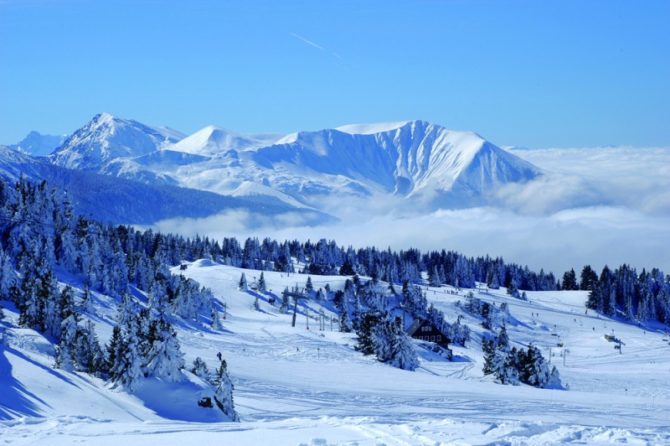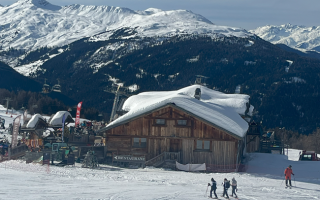Top Secret Slopes

France boasts some of the most sought-after ski slopes in Europe: Chamonix, Courchevel, Megève, Les Deux Alpes, Alpe-d’Huez and Val d’Isère among others. But you don’t have to travel to the big-name playgrounds of the Alps to find top-notch skiing. Smaller mountain ranges such as the Vercors, in the Drôme département, and the Massif de Belledonne in the Isère also offer excellent and varied skiing in delightful small resorts.
Both of these mountain ranges lie within roughly an hour and a half’s drive from Lyon, and it’s perfectly possible to leave France’s second city in the morning and be on the slopes by 10 am—or at least be enjoying a pre-piste coffee—with very little effort. They are even closer to and equally accessible from Grenoble. An urban ski break or just a couple of days on a winter getaway is a real possibility, and being based in a big city rather than a mountain resort means a wider choice of eating out, entertainment and general enjoyment for those who are not keen skiers.
Local resorts like Villard-de-Lans in the Vercors or Chamrousse in the Belledonne are often less crowded than their big brothers, especially in mid-week, and they are less expensive, too. A single-day ski pass in Villard-de-Lans costs €33,50; the same price as in Les Deux Alpes. You are also less likely to get stung for an exorbitantly priced hot chocolate, too. Obviously the bigger resorts offer more runs, but for day trippers, small can be very beautiful indeed.
A gem of a resort, Villard, or to give the ski domain its full name, Espace Villard-Corrençon, has nearly 80 miles of pistes; eight black runs, nine reds, nine blues and eight greens. It is a mid-altitude resort—the highest point is 6,700 ft. On the one hand this means that most of the pistes run through pine and spruce forests, so it can be chocolate-box pretty, especially with fresh snow glittering on the branches.
On the other hand, of course, there is global warming. Villard and its mid-high ilk are less snow-sure. Unlike Tignes or Les Deux Alpes there is no glacier, so there is no autumn opening and no spring skiing into May. In fact, the Alpine conservation society CIPRA estimates that resorts below about 4,000 feet will not stand a chance within 50 years. That caveat duly given, I have skied in Villard many times over the past seven years, and the snow has always been good.
Villard also offers technical sections for advanced skiers and steep powder fields, small cliffs and masses of off-piste possibilities. The black slope that shoots into the village of Villard is named the Carole Montillet, after Villard’s own 2002 Olympic downhill champion. But there are also much gentler pistes—wide, well-groomed runs where beginners can find their ski legs and intermediates can perfect their carving turns.
Huskies and Horses
There are nine other, smaller ski resorts in the Vercors, including Autrans on the opposite side of the Vercors plateau. The plateau itself has a slightly otherworldly feel. The road starts climbing a few miles beyond the autoroute, swinging around hairy hairpin bends. After a few tiny, very rustic villages, a canyon looms. The road follows the river, with walls of rock towering above and teetering mushrooms of fluffy snow balanced on the outcrops of stone. Opening out of the canyon, the plateau is, depending on the weather, either an expanse of hazy winter colors or a sheet of dazzling white, with mountain peaks on either side.
Downhill skiing is not the only winter attraction in this unsung winter wonderland. There’s also dog sledding, with eight centers for traineaux à chiens in the Vercors national park. The Arctic custom of traveling with huskies reached the Vercors in the early part of the last century, as a way of getting around in winter storms. Jacques Gaspard, owner of the sledding company Kiska Vercors in Vassieux-en-Vercors, was one of the first to bring the pursuit to a wider public, starting in 1982. At Kiska, neophytes can learn to harness and drive a team of huskies, either for a day, a weekend or a five-day trip. For those who get hooked, Gaspard also offers trips to Finland at the end of the winter season. His dogs are Alaskan huskies, used in teams of four or five. Traveling with these “mythical” dogs, he says, gives people a new vision of the Vercors wilderness.
So does ski joering — in English skijoring — a bit like waterskiing but powered by a horse instead of a boat. The skier holds onto a bar, similar to those used in waterskiing, which is attached to long reins. Like dog sledding, horse-drawn skiing started as a means of getting around in bad weather. Centuries later it became leisure time fun, and then a competitive sport. Franck Beaudoing, based in Corrençon-en-Vercors, runs a riding center that also offers skijoring. Visitors who want to try it, he says, need to be both at ease on skis and not afraid of horses. While beginners glide around at a sedate pace, Franck also offers courses for the more experienced, including galloping and even slalom.
Belledonne Duo
Farther east from Lyon, the Belledonne mountain range offers four main ski resorts, including Chamrousse and Les Sept Laux. Chamrousse is often considered the crucible of French downhill skiing. In the late 19th century the alpinist and ski pioneer Henry Duhamel tried out a pair of skis—at the time little more than planks with upturned toes—in Chamrousse for the first time. Apparently he soon established that it was quicker to go down than up on skis, but it took several years before he was able to turn and, more importantly, stop, without the help of a tree.
Surrounded by forests of spruce trees, Chamrousse was popular in the 1950s but really took off after the Winter Olympics of 1968 in nearby Grenoble, when Jean-Claude Killy won his three Olympic gold medals on Chamrousse slopes. The resort hosted six events in those Olympics.
The area has more than 50 miles of pistes; seven black runs, seven reds, 15 blues and six greens. Chamrousse is based around two villages, Recoin at 5,400 ft and Roche Béranger at 5,700 ft. The highest point is the Croix de Chamrousse, at nearly 7,400 ft, which boasts an amazing 360-degree panorama of the Alps. Family-friendly Roche Béranger is more oriented toward beginners and intermediates, while the Recoin area harbors most of the more difficult runs. And not far from Recoin is Casse-Rousse, where the couloir offers a 2,800-ft descent. Prices in Chamrousse are also very reasonable, with day lift passes at €32,50. A welcome addition to the pass menu is a flexible forfait for four consecutive hours, meaning you can start any time you please. Chamrousse is also attracting a fair amount of new investment—2010 saw the opening of a new cabin lift up to the Croix de Chamrousse, also accessible to non-skiers.
Les Sept Laux in the Belledonne is one of the larger local resorts, with 77 miles of ski runs at altitudes ranging from 4,400 ft to a healthy 7,900 ft. It’s spread out across three centers: Le Pleynet on one side of the mountain and Pipay and Prapoutel on the other. Earmarked as one of the key Isère resorts by the regional government, Les Sept Laux has attracted hefty investment. Around 90% of the lifts have been replaced over the past decade. One of the new installations is the Grand Cerf Combi—an unusual mix of chairlift and cabin on the same cable.
Les Sept Laux also has a reputation as something of an off-piste paradise. Its slopes make the most of a series of bowls on the two sides of the mountain, which mean that there is always some good snow somewhere.
There is not a huge amount of accommodation here, so après-ski is limited and the clientele is almost exclusively French. The resort was designed in the early 1960s. The original study for it was done by Laurent Chappis, who also created the French ski resort of Courchevel in Les Trois Vallées. Chappis spent five years as a POW during World War II, and actually completed his doctorate on the development of a ski resort while in captivity.
Characteristically controversial, Chappis—who was nicknamed the “anarchitecte“—suggested that the main accommodation at Les Sept Laux should be based lower down the mountain for environmental reasons, and skiers could be whisked up to the slopes by a high-speed lift. He was ahead of his time, however, and the developers decided to stick with the traditional ski-to-the-door model.
Although the origin of the name is not certain, it is often thought to refer to the seven glacier lakes on the nearby plateau—which make Les Sept Laux a great destination for some rugged summer hiking too.
Kiska Vercors, Les Curies du Caribou
From the France Today archives
Share to: Facebook Twitter LinkedIn Email



